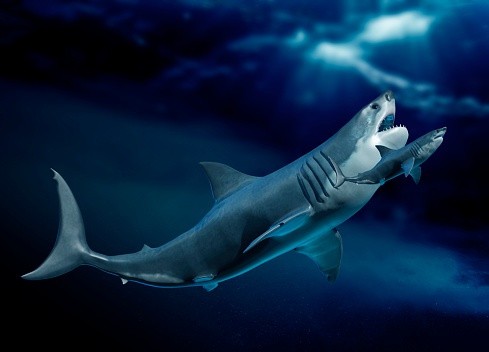Even confirmed by science that they are already extinct, Megalodon Sharks are frightening, based on the facts collected by the scientist.
Megalodon or "big tooth" bite can crash a car. According to a study, a giant megalodon shark may have broken a whale's back after a vicious attack around 15 million years ago.
In a paper published in Palaeontologia Electronica, the document states an analysis of the cetacean vertebrae discovered in Maryland.
It shows signs of compressed fracture trauma that the researchers said was most likely a result of a predation attempt by a large marine predator, particularly a megalodon shark, although they also put forward other possible explanations.
A cetacean is a group of aquatic mammals which includes porpoises, whales, and dolphins. The cetacean's vertebrae were found in the Calvert geologic formation across Maryland, Virginia, and Delaware. As the scientists studied the fragments, they discovered that the fossils belong to the Miocene epoch, around 23 million to 5.3 million years ago.
Extinct But Iconic
Megalodon, scientifically named otodus megalodon, is an iconic shark species -the largest to ever live on Earth's waters-that scientists believe went extinct around 3.6 million years ago. The earliest retrieved fossil of the megalodon dates back more than 20 million years.
This shark species is also considered one of the biggest and most powerful predators ever lived.
According to the National History Museum in London, scientists estimate that it could have grown to roughly 50 to 60 feet in length.
According to the researcher of the Palaeontologia Electronica, a megalodon shark may have been responsible for the breaks in the bones of the recovered fragments of cetaceans. They described the breaks as "sufficiently unique," as they examined the remains.
The researchers said that the kind of physical trauma seen in the vertebrae is extremely rare. Maryland's Calvert Marine Museum Paleontologist Stephen Godfrey said that "in terms of the fossils we've seen on Calvert Cliffs, this kind of injury is exceedingly rare," the scientist told LiveScience.

ALSO READ : Video Footage Showing Deep-Sea Sharks Ignite Argument That Megalodon Still Lives Beneath the Large Ocean
Cetaceans' Vertebrae Injury
Godfrey described the injury as nasty, and that resulted in serious trauma and uttered to know the backstory. Joining with his colleague researcher, Brian Beatty from the National Museum of Natural History and New York College of Osteopathic Medicine, they have decided to conduct a CT scan of the vertebrae that measured around 13 feet long.
The vertebrae resemble the exact type of whale but are not determined; the bones may belong to a dolphin.
CT scan results revealed that the vertebrae suffered from compression fractures, and they described the injury as severe caused by a large predatory shark like megalodon or its close relative marine predator.
Apparently, a single megalodon shark tooth was found with the vertebrae, strengthening the claim that the shark was responsible for the attack. But the researchers didn't confirm it since several explanations can solve the claim.
Scientists have hypotheses about the embedded tooth in the cetacean body. The first is a result of a bite associated with physical trauma. Second, the shark who killed the cetacean could have shed the tooth.
The third is the tooth could end up by chance. And finally, the shark shed the tooth as it scavenged the cetacean carcass.
Despite the physical trauma, the evidence suggests that the cetacean did not die right away and survived between 6-8 weeks based on the signs of healing seen in the bones.
RELATED ARTICLE : Terrifying Megalodon Had a Massive Penis About The Size of a Great White Shark, Expert Says
Check out more news and information on Sharks in Science Times.
© 2025 ScienceTimes.com All rights reserved. Do not reproduce without permission. The window to the world of Science Times.









